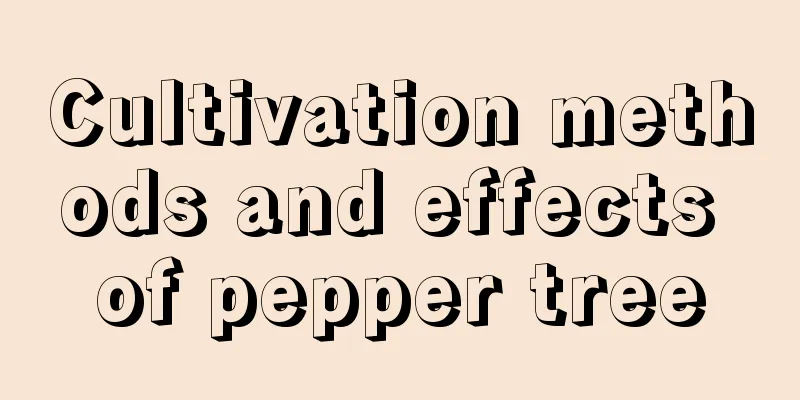Cultivation methods and effects of pepper tree

|
Pepperwood is an evergreen shrub belonging to the genus Zanthoxylum. The leaves of the pepper tree are delicate and dark green, with a strong fragrance and high ornamental value. It is suitable for planting in parks, courtyards, amusement areas and other places. Let’s talk about the cultivation methods and effects of the pepper tree. 1. Sunlight Choose a suitable breeding environment. Pepperwood likes bright light. Make sure that the pepperwood can get at least 6 hours of sunlight a day. This is essential for its healthy growth and bright leaf color, but it needs to avoid direct exposure to strong sunlight to prevent damage to the leaves. 2. Temperature and humidity Pepperwood prefers a warm environment, and the most suitable temperature range is between 18-24 degrees Celsius. Choose a location that is bright but out of direct sunlight, such as near a window. At the same time, pepperwood also needs a certain amount of humidity to keep the leaves shiny and prevent them from drying out. You can increase the humidity around it by misting water or placing a water tray. Alternatively, increase humidity by using a humidifier or placing the plant on moistened pebbles. 3. Watering Keep the soil moist but don't overwater, which can cause root rot. Generally speaking, watering once a week is sufficient, and the specific frequency of watering should be adjusted according to the local climate and season. During the winter, pepperwood requires less water. Pepperwood prefers moist soil but does not like overwatering. Normally, water when the soil surface is slightly dry to avoid waterlogging. 4. Fertilization Use a fertilizer that's appropriate for houseplants and follow the directions for fertilizing. Pepperwood needs adequate nutrition during the growing period, and you can choose fertilizers suitable for indoor plants for fertilization. Generally speaking, it is sufficient to apply fertilizer every 2-3 months. Keep in mind that over-fertilizing may cause potted plants to grow too fast, which could cause root burn and affect their health. 5. Pruning The pepper tree will produce branches and leaves during its growth process. If it is not properly pruned, the plant will become too lush and affect its appearance. Therefore, regular pruning of your pepperwood is key to maintaining its shape and health. If you find that the plant is becoming too lush or has yellowing leaves, you can use scissors to trim off the excess branches and leaves. At the same time, you can prune off overly long branches and parts damaged by pests and diseases to promote new growth. Additionally, regular pruning can encourage new growth and make the plant fuller. 6. Pest and disease control Pepper trees are susceptible to pests such as aphids and spider mites, so check the plants regularly for pests and take appropriate control measures. At the same time, pay attention to keeping the indoor ventilation and avoid excessive humidity to reduce the possibility of germs breeding. That’s it |
<<: How to prune peonies in winter? Will they freeze to death in winter?
>>: How do peonies survive the winter outdoors in the north? Do peonies shed their leaves in winter?
Recommend
How often should I water Jianlan (Jianlan is prone to rot if I water it, and its roots become empty if I don't water it)?
How often is it best to water Jianlan? In fact, t...
What fertilizer to apply before grape vines bloom (when is the best time to apply fertilizer before grapes bloom)
Grapes generally need to go through multiple grow...
How to care for the Jerro Rose Succulent and make it pink
The flowering period of the Yerro Rose succulent ...
The value of sea daffodils
The ornamental value of sea daffodils The floweri...
The Flower Gods and Flower Languages of the Twelve Months
1. January to April January is the month of plum ...
What soil is best for white palm
The soil for planting anthuriums should not be to...
Can maple trees survive by grafting?
1. Can it be inserted alive? Maple trees can surv...
When does the purple bamboo plum bloom?
1. Flowering period: The flowering period of Purp...
How much cotton yield per mu
Cotton yield per mu Under normal circumstances, t...
How to increase the survival rate of dragon bone cuttings?
The dragon bone is a spectacular and easy-to-care...
Can lychees be grown in Chengdu?
Can lychees be grown in Chengdu? Chengdu is a pla...
Willow Growth Environment Conditions and Characteristics
Willow Growth Environmental Conditions and Requir...
The difference between Magnolia grandiflora and Magnolia
1. Different flowering periods Generally speaking...
Four seasons maintenance method of jade fan
Spring and Autumn Maintenance of Jade Fan The two...
Why are the leaves of jasmine dry and green?
The phenomenon of jasmine leaves turning green In...









